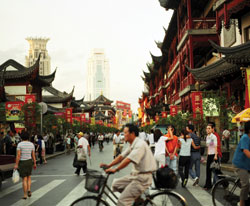This is the fourth and final article in a series on the BRIC countries, Brazil, Russia, India and China. Please submit suggestions for future international articles to lori@har.com.
For centuries, China has been a leading civilization in the arts and sciences. But in the 19th and early 20th centuries, the country was beset by civil unrest, major famines and foreign occupation. More current history (1920s-70s) shows that China was under severe turmoil and political revolution with the expulsion of the Japanese, creation of the Communist Party and violent, sweeping land reform. This absolute control created a staunchly isolated, self-sustaining agriculturally-based society that imposed strict controls over everyday life.
China, which has tremendous natural resources, was transitioning from an agrarian society to an industrial one, and with this new economic development came social and technological changes. This growth would not be overlooked by the world leaders, and in 1972, President Richard Nixon visited Chairman Mao Zedong to establish global relations between the two world powers.
After 1978, Mao’s successor, Deng Xiaoping, greatly opened China to the world by focusing on manufacturing, exporting and improvement of global relationships. By 2000, output had quadrupled and China was being recognized as one of the strongest industrial providers. Fast forward to modern days and we see that in 2010, China became the world’s largest manufacturer, ending the United States’ run for more than a century. The value of China manufacturing output in 2010 was $1.995 trillion or 19.8% of the worldwide total, edging out the United States which accounted for 19.4% worth or $1.952 trillion.
Today, the impoverished and isolated country that Nixon visited is history and global reintegration has turned China into an economic powerhouse. It is the world’s largest exporter in volume terms, and is the world’s second largest economy. China’s presence is felt around the world, from mines in Africa to Apple stores in the United States. China is the most populous nation with more than 1.3 billion people and is home to one of the fastest-growing economies with double-digit growth each year for the past three decades.
China is a major contributor to the BRIC group of countries and is part of these successes:
- BRIC accounts for 26% of the world’s landmass and 42% of the global population, including India and China, two of the world’s most populous countries.
- BRIC accounts for 40% of global GDP ($18.486 trillion) and its proportion is rapidly increasing. Goldman Sachs predicts that “BRIC can become collectively bigger than the G-7 (the top industrial powers) by 2035”. BRIC countries have accounted for more than 50% global economic growth in the last decade.
- Intra-BRIC trade is growing at an average of 28% annually and currently stands at about $230 billion.
How Long Can This Ride Last?
Although nobody is predicting the Chinese economy will crash, the question of “How long can this export and investment-led economy last?” is being reviewed. Credit Suisse’s China economist, Dong Tao, sounded a cautious note about the outlook for the Chinese economy, predicting that the next official economic figures would surprise by being on the downside and that the growth rate this year would come in at about 7.5%.
Does this mean that Chinese might be looking elsewhere for investment opportunities? According to a survey by the National Association of REALTORS®, Chinese buyers accounted for 9% of foreign home purchases in the United States in the 12 months ending in March of both 2010 and 2011. That’s up from 5% in 2009. “The purchase restrictions in China drove them overseas, while they look for investments to counter the inflation,” Mo Tianquan, founder and chairman of Beijing-based SouFun Holdings Ltd. – a company that runs China’s biggest real estate Website and organizes buying excursions abroad – told Bloomberg. “Some of them will buy homes considering better education opportunities for their kids, while others look for immigration options.”
Many Chinese are seeking foreign real estate investments due to purchasing restrictions in China (implemented in an effort to curb inflation) as well as pursuing better educational opportunities for their children and other business investment opportunities. Combine these restrictions with the down real estate cycle in the U.S., and interest in purchasing has piqued Chinese interest.
Michael Knowles is a member of the 2012 HAR International Advisory Group and an agent with RE/MAX Grand in Katy.


